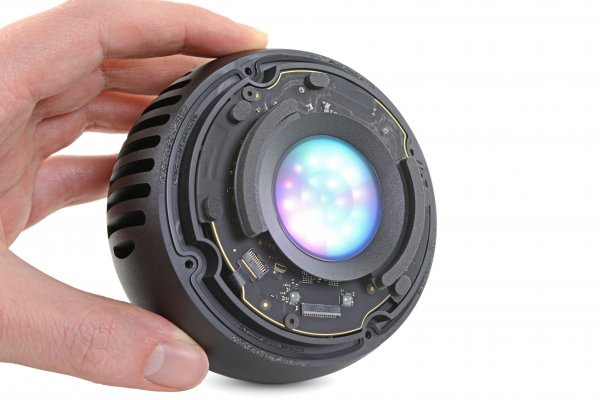The HomePod 2, successor to the original 2018 HomePod, was described by Marques Brownlee as one of Apple’s most confusing new products. With six microphones cut down to four, seven tweeters cut down to five, a humidity sensor that’s in the Mini already, and not much else—why is it even here? Could there be more to it?
The most significant update is that the HomePod 2 can be opened without destroying it. While our friends in the repair community have figured out non-destructive ways to get into the original HomePod, it’s fair to say that a glue-free opening procedure is always appreciated.
Now that there’s an easy way inside, we’re presented with an opportunity to maintain and repair the device—at least in theory. We’re still performing tests, but parts pairing may once again be rearing its ugly head. From the limited testing that we’ve carried out so far, it seems that changing the humidity sensor alone will prevent any audio output even though the speaker says it’s playing. This may be parts pairing or it may be a bug. We’re still testing, but we observed the exact same problem when we switched out the amplifier board, too. While these aren’t the most likely candidates for replacement, they’re not a great sign, either.
As if the potential software blocks weren’t bad enough, the woofer in the original HomePod and the HomePod 2 appear to be functionally identical except for the handy JST connector. The HomePod uses a two-pin connector and the HomePod 2 uses a three-pin connector. “Well hold on”, I hear you say. “That additional pin probably connects to Starlink or something, right? Surely you need that extra pin to hook into the Pentagon’s supercomputer to get your iTunes playlist organized?”
Brace yourself for this. That center pin is…empty, it does nothing—it’s just an empty bit of plastic. Well we shouldn’t say it does nothing, it does make this woofer incompatible with the OG HomePods’. Luckily, it seems fairly easy to snip the cable and change the connectors around but we’re still left wondering: “why?”
Like the original HomePod, this one also uses a class-D amplifier to drive the speaker array. Amplifiers come in different classes, and class-D amplifiers are able to output high power to the speakers with good power efficiency and low distortion. Of course, with great power, comes great amounts of heat.

As pointed out in Nic’s Fix’s teardown video, the oversized heatsink on the amplifier not only helps to dissipate excess heat (and its accompanying audio distortions) away from the amplifier board, but it also appears to be a fix for a heat management problem that was damaging the drivers in the HomePod 1.
The S7 chip, essentially a rebranded S6, is the same one Apple used in the Watch Series 8. For comparison, the original HomePod used Apple’s A8 Bionic chip. Both chips are capable of running the HomePod and we suspect that the reason for using the S7 may well have more to do with optimization, inventory, supply chain, or manufacturing considerations (likely all of the above) rather than any real performance requirements.

Overall, it’s just a HomePod. From a repairability and sustainability standpoint, it’s great to have a more considered, less glue-filled way in. That said, it was disappointing to see the woofers rendered incompatible thanks to differing connectors across models—especially such a superficial change. It will be more difficult to find, and tougher to substitute parts that would otherwise be compatible. In this instance there’s a workaround, but it brings to the fore the desperate need for manufacturers to think longterm during their product design process.
As for the device itself, is it better than the original HomePod? Given the streamlined access the internals, maintenance and repair hurdles are much reduced—so I’d say, yes. Unfortunately, we never know how parts pairing will affect even the best intentions. Even for something as minor as replacing a humidity sensor.





0 Comments